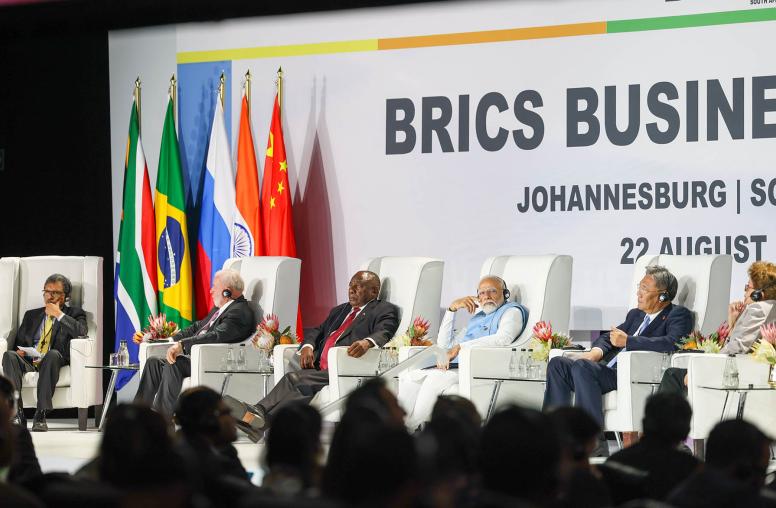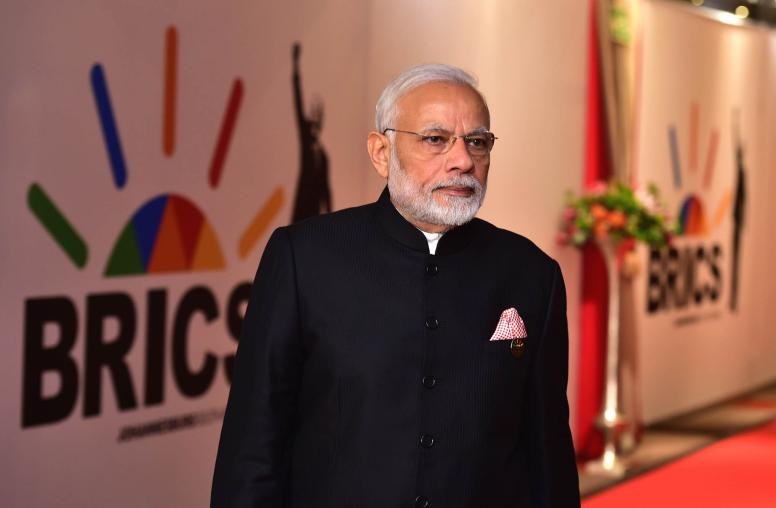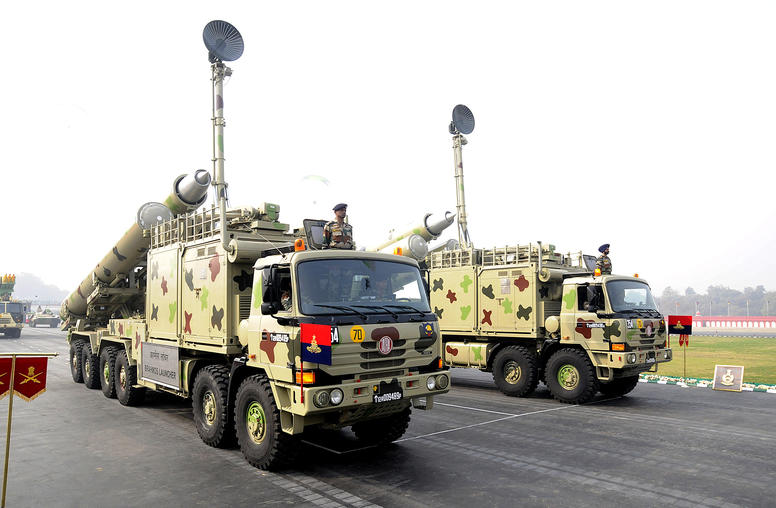How to Deal with the Risk of Nuclear Escalation in South Asia
An accidental missile launch from India underscores the need for more reliable de-escalation measures in the region.
Two months ago, India accidentally launched a missile 75 miles into its rival Pakistan’s territory. Although many U.S. policymakers could be excused for having both eyes on the Russia-Ukraine conflict, for those pursuing stability in the Indo-Pacific, this was a reminder of the nuclear risks endemic to the region.

The incident began when a cruise missile was launched from an Indian base near Sirsa the evening of March 9. The missile traveled through civilian airspace and landed in the Pakistani city of Mian Channu, damaging some property without inflicting any casualties. Pakistan’s military publicly briefed on the incident the following day — but it took India 48 hours to issue a terse statement acknowledging the missile accidentally fired “in the course of routine maintenance.” The Indian defense minister’s statement promising an investigation may also indicate India had not even tracked the missile’s trajectory.
Luckily, this incident occurred in peacetime, amid a cease-fire agreement between the two rivals that has proved surprisingly durable for 15 months. Reports later surfaced that Pakistan had prepared a “retaliatory strike,” but held back.
If such an accidental missile launch occurred during the most recent India-Pakistan crisis in 2019, it could have been catastrophic. Mishaps that occur during the fog and friction of a militarized crisis can easily escalate. And accidents endemic to large, complicated military organizations — like a rogue missile launch, a false missile attack warning or the shoot down of a commercial plane — can rapidly spiral out of control. The incident exposed the risk for dangerous accidents with advanced weapons systems and a concerning inability or unwillingness to quickly alert a rival to the accident, even through an existing military hotline.
Recalling the 2019 Crisis
India and Pakistan are no strangers to militarized crises, and the 2019 Balakot crisis ultimately did not result in a war. However, the intensity and speed of escalation was alarming to scholars and practitioners. It is worth recounting some of the close calls and accidents during the crisis that have since come to light.
After a suicide bomber killed 40 Indian paramilitary troops in a February 14 attack claimed by Pakistan-based terrorist organization Jaish-e-Mohammad, the Indian military conducted a retaliatory airstrike 12 days later on what it alleged was a terrorist training camp within Pakistani territory. This was the first time that one nuclear-armed country had conducted airstrikes on another nuclear-armed country’s territory.
The following day, Pakistan responded with its own airstrike close to the Line of Control that separates the disputed territory of Kashmir. Indian fighter jets attempted to intercept Pakistan’s air forces, and in the aerial skirmishes, an Indian fighter jet was shot down and a pilot captured. An Indian air defense unit, in a “panic reaction,” also shot down an Indian Mi-17 helicopter, killing all six military personnel on board. A subsequent investigation revealed this to be a byproduct of systems integration problems and human error.
A less visible but intense set of moves and countermoves was also unfolding at sea. The Indian Navy later claimed to have “aggressively poised” its forces to bottle up the Pakistan Navy and deployed naval nuclear assets. Indian surface ships, maritime patrol aircraft and India’s sole attack nuclear submarine actively hunted for one Pakistani submarine that had vanished from Indian tracking and was feared to threaten India’s Western coastal region. A few days after Pakistan released the captured Indian Air Force (IAF) pilot to Indian custody, Pakistan’s Navy claimed to have detected and thwarted an attempt by an Indian submarine to enter its territorial waters, although the Indian Navy denied the incident.
Most concerning, the air battles seemed on the verge of sparking a rapid escalation. Insider accounts suggest India communicated to Pakistani officials that India had readied its “deployment” of surface-to surface missile batteries, which had been “primed” and “aimed at high value targets inside Pakistan.”
Several Indian officials, including cabinet members, reportedly believe that the missile deployments, the “red alert” status of the Indian military, and the fact that Indian leadership “was prepared to go down the missile road” are what compelled Pakistan’s military and prime minister to agree to the captured Indian pilot’s release on March 1. In remarks later in April on the campaign trail before the 2019 parliamentary elections, Indian Prime Minister Narendra Modi claimed credit for “[keeping] 12 missiles ready” if the IAF pilot was not released and threatening a “night of bloodshed.”
Implications of the 2019 Crisis
Several general lessons from this crisis have been catalogued by scholars. Both India and Pakistan have strategic and political incentives to manipulate risks and they believe they have calibrated control over escalation.
But the two rivals are prone to miscalculations and accidents in the heat of crises. Leaders may not be accessible or responsive to third-parties seeking to diplomatically terminate the crisis, and may quickly reach for nuclear-capable platforms early in the crisis, which can result in inadvertent escalation.
There were also conclusions to be drawn about crisis termination. One is the importance of good luck. Had the Pakistanis accidentally hit the brigade headquarters where two senior Indian Army commanders were present, or had the Indian pilot been killed in flight or in custody, that could have prompted further rounds of airstrikes and conflict escalation.
One surprise was the potential utility of misinformation and disinformation. While some former U.S. officials worried that the ambiguity around certain facts and signals made the crisis more dangerous, the absence of a clear, authoritative account of what occurred allowed both sides to plausibly claim a victory and climb down from conflict. For instance, the Indian account claims the missile escalation threats catalyzed external pressure on Pakistan to blink and release the pilot. By contrast, Pakistani military insiders contend U.S. pressure on India got it to back down from missile threats, which in turn allowed for the pilot’s release.
Scholarship on the role of secrecy and collusion in escalation management suggests misinformation can be leveraged to allow face-saving exits. The downside of this, though, is that both sides may be emboldened to run similar risks in the future. An information paradox can mean misinformation proves stabilizing within crises but destabilizing for deterrence more generally.
What Can Be Changed to Avoid Future Crises?
While the United States may normally be focused on other priorities in peacetime, it quickly realizes it has a significant stake in de-escalating a crisis between two nuclear-armed adversaries. A future India-Pakistan crisis could threaten U.S. national security interests including the maintenance of the nuclear taboo, the safety of its hundreds of thousands of citizens living in the region, and the durability of its “Indo-Pacific Strategy.”
Historically, the United States has played a central role de-escalating previous South Asian crises. Some Indian and Pakistani analysts downplay the risks of nuclear escalation or suggest 2019 showcased the maturity of the rivalry and stability of deterrence, but there is reason to think the co-belligerents will still call upon the United States to help manage future crises.
While the United States seemed to take a less visible approach to the 2019 crisis than in past cases, after India and Pakistan exchanged missile threats on the night of February 27, U.S. officials — including National Security Advisor John Bolton and Secretary of State Mike Pompeo — reportedly played a significant role in defusing the crisis by brokering the return of the Indian pilot.
In the future, the United States will have to navigate some challenges. The first is that it if the crisis appears to begin with a terrorist attack on Indian soil, as they often have over the past two decades, Washington will need to signal empathy and support for India without necessarily appearing to encourage the kinds of actions that can result in inadvertent escalation.
The United States will also need to possess reliable channels of communication with the senior political leadership of both countries throughout the crisis so that it can convey its position clearly and quickly and facilitate de-escalation. However, these channels are difficult to build given there hasn’t been a Senate-confirmed U.S. ambassador to India in almost 18 months, and to Pakistan in five years. Communication channels cannot guarantee the United States will be able to shape behavior, but it should at least be able to reach the senior-most Indian and Pakistani leaders when they need to.
Rather than waiting until the next crisis to spring into action, the United States can help both sides develop their own crisis management tools now. The new USIP Senior Study Group report offers valuable ways forward — including enhanced intelligence, communication links, information sharing and dialogue venues. Even without taking a position on conflict resolution, the United States and its partners that have a stake in South Asian stability could more proactively encourage several of these communication- and confidence-building measures to mitigate the consequences of future accidents and crises.
Sameer Lalwani (@splalwani) is a senior fellow for Asia strategy at the Stimson Center and a nonresident fellow with the Sigur Center for Asian Studies at George Washington University.




